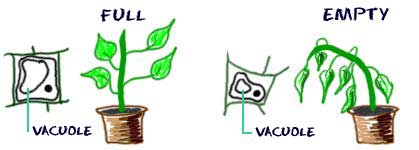Strong Cytoskeleton
If your slimes are single cells, you're going to run into some huge problems. Cells are filled with a fluid called cytoplasm, which is contained within the cellular membrane. In essence, cells are like little water-filled bags. If your slime is only one cell, it can't be very slimy, because you don't want that bag to burst and leak the slime's guts everywhere. Your slime's ability to move, and its ability to "flow" or "leak" will be constrained by its outer "skin" as long as it's a true cell. I'm going to answer your question as best I can while maintaining the "one cell" constraint.
If you really want to have just one cell, I suggest evolving a very strong cytoskeleton. This is the organelle that gives cells structure, and helps them expand, contract, divide, and move. A microscopically-thin cytoskeleton might not work on the scale of a massive slime, but you can always make it thicker. This is a really simplified explanation of a complex structure, but it's a start.
By adjusting its cytoskeleton, a slime can achieve locomotion. It can conceivably change its shape - and by relaxing or tensing this organelle, it may be able to act more fluid or more rigid. Various cytoskeletal components are shown below in red and green.

Many Vacuoles
Sticking with the "giant cell needs need giant organelles" theme, another direction to move in is vacuoles - the large, storage organelles that plant cells use to hold water. In plants, full vacuoles provide structural support, while empty vacuoles leave plants sagging.
You could give your slimes thousands of small vacuoles that similarly allow for different degrees of cellular rigidity. Slimes could move water in and out of their vacuoles to go from rigid to soft. Keep in mind that moving water into or out of the cytoplasm wouldn't cause a net change in viscosity. Your slimes would need to soak up ambient moisture or leak some water to become more or less fluid.

Thick Cytoplasm and No Cellular Membrane
If you want your slimes to be "cells" in that they aren't composed of smaller cells, you might be able to get away with stripping away the outer membrane that keeps the cytoplasm contained. You would need to thicken the cytoplasm (inner fluid) a LOT so that the cell doesn't just turn into a puddle. No cell ever seen on Earth has done this, but if your slimes are large enough and thick enough, they might be able to pull it off. Getting your cell to move with no membrane to push or pull on would be really difficult, unless you developed "muscle" organelles. But it would be runnier - and thus a lot more "slimey" - than a single-celled organism.


